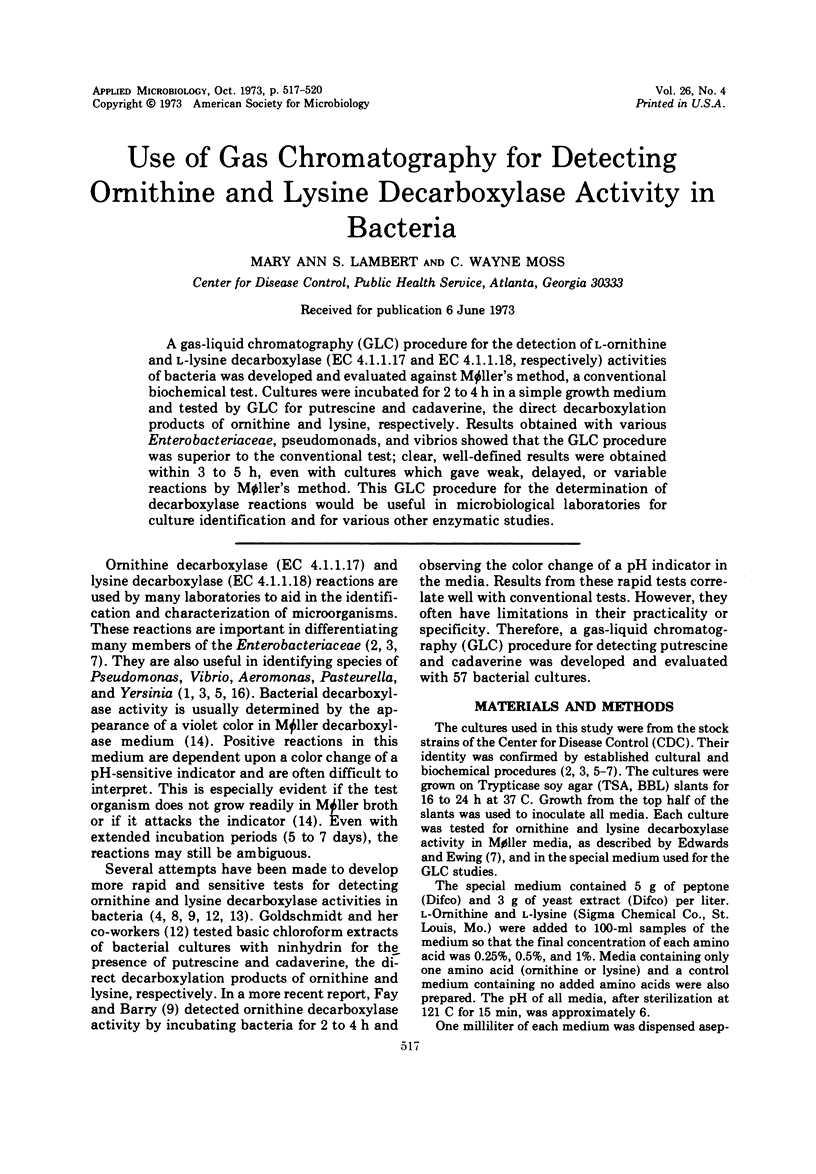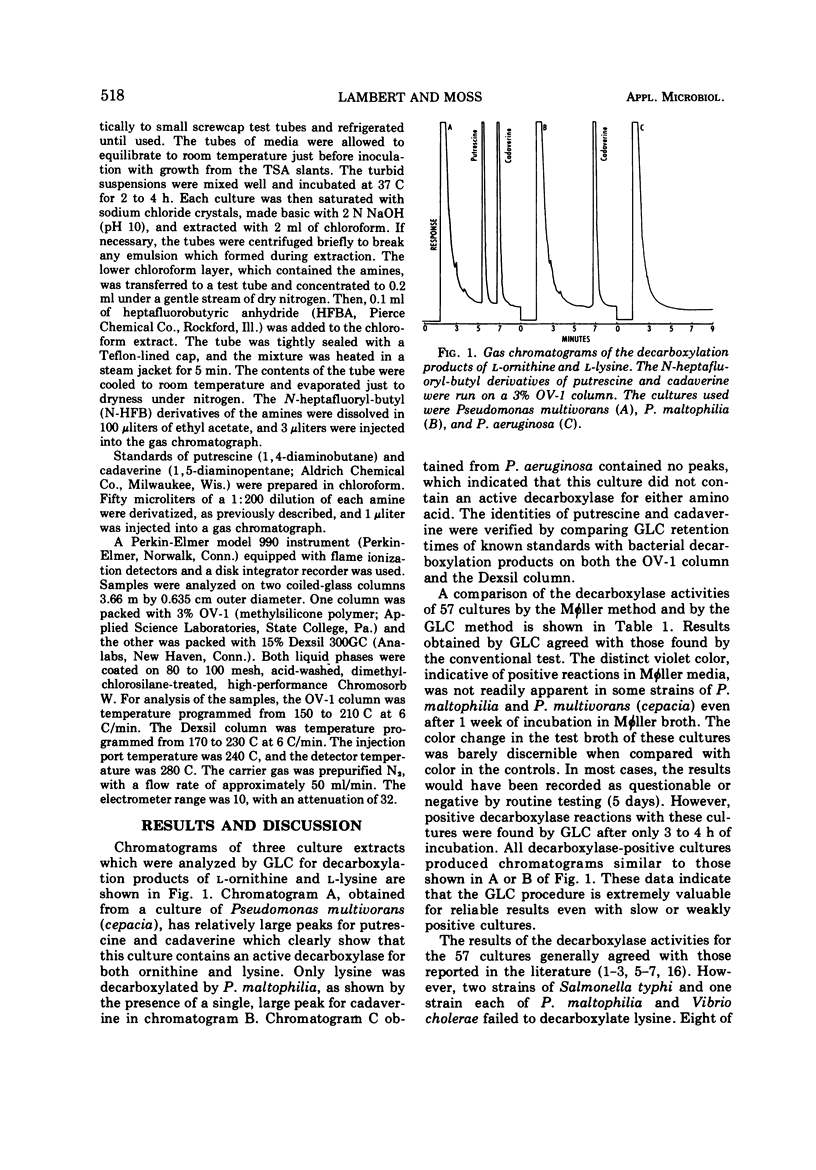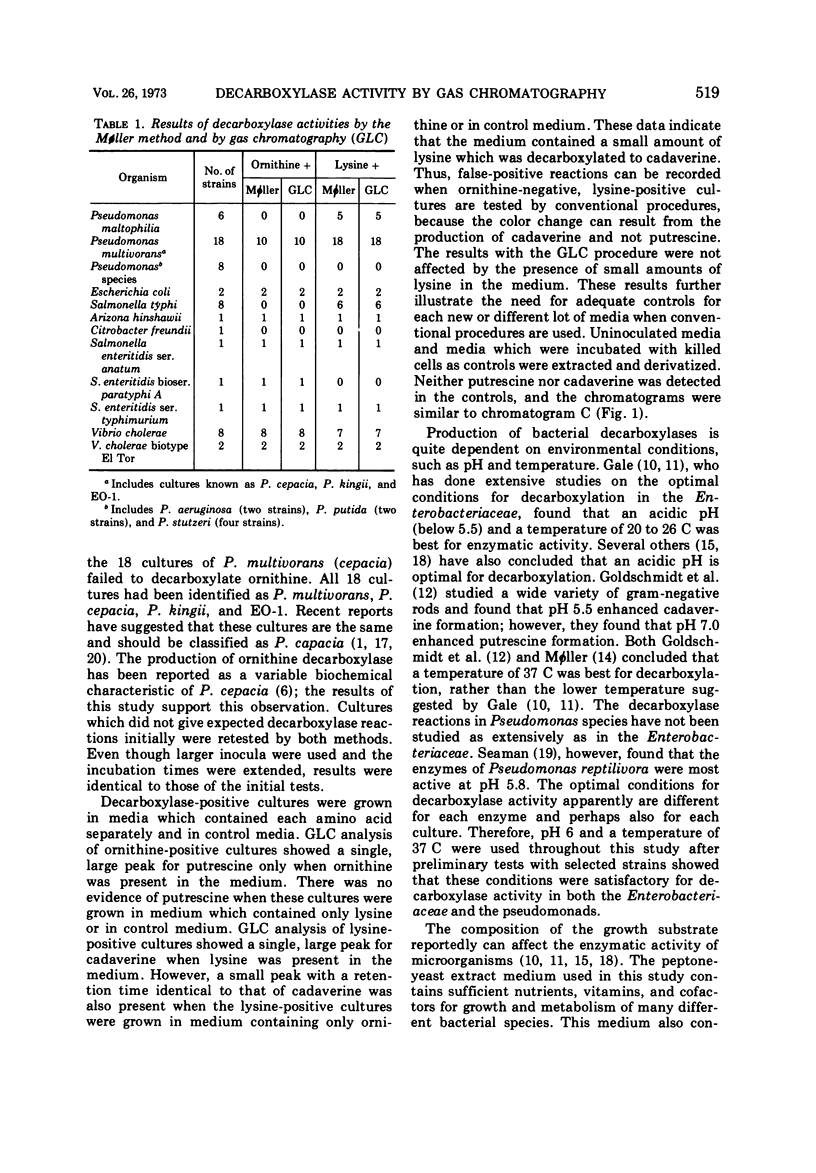Abstract
A gas-liquid chromatography (GLC) procedure for the detection of L-ornithine and L-lysine decarboxylase (EC 4.1.1.17 and EC 4.1.1.18, respectively) activities of bacteria was developed and evaluated against Møller's method, a conventional biochemical test. Cultures were incubated for 2 to 4 h in a simple growth medium and tested by GLC for putrescine and cadaverine, the direct decarboxylation products of ornithine and lysine, respectively. Results obtained with various Enterobacteriaceae, pseudomonads, and vibrios showed that the GLC procedure was superior to the conventional test; clear, well-defined results were obtained within 3 to 5 h, even with cultures which gave weak, delayed, or variable reactions by Møller's method. This GLC procedure for the determination of decarboxylase reactions would be useful in microbiological laboratories for culture identification and for various other enzymatic studies.
Full text
PDF



Selected References
These references are in PubMed. This may not be the complete list of references from this article.
- Ballard R. W., Palleroni N. J., Doudoroff M., Stanier R. Y., Mandel M. Taxonomy of the aerobic pseudomonads: Pseudomonas cepacia, P. marginata, P. alliicola and P. caryophylli. J Gen Microbiol. 1970 Feb;60(2):199–214. doi: 10.1099/00221287-60-2-199. [DOI] [PubMed] [Google Scholar]
- CARLQUIST P. R. A biochemical test for separating paracolon groups. J Bacteriol. 1956 Mar;71(3):339–341. doi: 10.1128/jb.71.3.339-341.1956. [DOI] [PMC free article] [PubMed] [Google Scholar]
- FALKOW S. Activity of lysine decarboxlase as an aid in the identification of Salmonellae and Shigellae. Am J Clin Pathol. 1958 Jun;29(6):598–600. doi: 10.1093/ajcp/29.6_ts.598. [DOI] [PubMed] [Google Scholar]
- Fay G. D., Barry A. L. Rapid ornithine decarboxylase test for the identification of enterobacteriaceae. Appl Microbiol. 1972 Apr;23(4):710–713. doi: 10.1128/am.23.4.710-713.1972. [DOI] [PMC free article] [PubMed] [Google Scholar]
- GALE E. F. Determination of amino acids by use of bacterial amino acid decarboxylases. Methods Biochem Anal. 1957;4:285–306. doi: 10.1002/9780470110201.ch8. [DOI] [PubMed] [Google Scholar]
- Goldschmidt M. C., Lockhart B. M., Perry K. Rapid methods for determining decarboxylase activity: ornithine and lysine decarboxylases. Appl Microbiol. 1971 Sep;22(3):344–349. doi: 10.1128/am.22.3.344-349.1971. [DOI] [PMC free article] [PubMed] [Google Scholar]
- KOTT Y. Lysine decarboxylase activity as a simple test in differentiation of Enterobacteriaceae. Nature. 1962 Oct 6;196:90–91. doi: 10.1038/196090b0. [DOI] [PubMed] [Google Scholar]
- MØLLER V. Simplified tests for some amino acid decarboxylases and for the arginine dihydrolase system. Acta Pathol Microbiol Scand. 1955;36(2):158–172. doi: 10.1111/j.1699-0463.1955.tb04583.x. [DOI] [PubMed] [Google Scholar]
- Pickett M. J., Pedersen M. M. Characterization of saccharolytic nonfermentative bacteria associated with man. Can J Microbiol. 1970 May;16(5):351–362. doi: 10.1139/m70-062. [DOI] [PubMed] [Google Scholar]
- SEAMAN G. R. Amino acid decarboxylases in a pseudomonad. J Bacteriol. 1960 Dec;80:830–836. doi: 10.1128/jb.80.6.830-836.1960. [DOI] [PMC free article] [PubMed] [Google Scholar]
- Samuels S. B., Moss C. W., Weaver R. E. The fatty acids of Pseudomonas multivorans (Pseudomonas cepacia) and Pseudomonas kingii. J Gen Microbiol. 1973 Feb;74(2):275–279. doi: 10.1099/00221287-74-2-275. [DOI] [PubMed] [Google Scholar]


